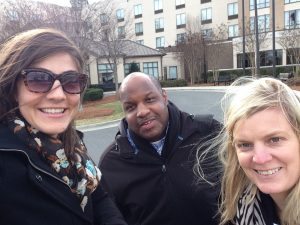This article is more than 5 years old.
Last Thursday, February 12th, I attended the Social Media Marketing Conference (SkillPath Seminars) in Charlotte, NC with fellow Communications Committee members Chris Burris & Rebecca Petersen. This conference was billed as “a real-world guide to understanding social media” and offered lessons for how to use social media to connect with your audience, expand your market reach, drive website traffic, and grow your brand.
What follows is a summary of some lessons learned and considerations for how to implement them into our current social media practice.
Getting off to a good start
There are many social media platforms (check out Brian Solis’ Conversation Prism), and many ways to use (and misuse) social media. 3 important questions we should ask when managing our social media platform(s):
- Why is this social marketing campaign being launched, and what are our goals and objectives?
- Who is target demographic? How are these audiences best engaged?
- How should patron relationships change as a result of this social media application? How will the success of the campaign be measured?
Knowing what you hope to achieve before you begin is key, and committing to an ongoing cycle of planning –> implementation –> measure/evaluate –> adjust will help keep social media strategies focused and effective.
Establishing goals and developing targeted social media strategies are practices that I would like to see us use in our communication efforts. Especially since we serve a diverse audience with multiple social media platforms and frequently have opportunities to share upcoming events, services and resources with our community.
The art of writing for a social audience
(A few quick tips)
Writing for a social audience encourages concise, engaging commentary. You want to make your point quickly, but with an entertaining emphasis. Here are a few quick tips:
- Do your research— know what type of content your readers/audience want and expect. Have an audience (or audiences) in mind when you are writing a blog, tweet, post, status update, etc.
- Write a “grabber” headline— lead with a compelling opener. Everyone appreciates as well-crafted hook.
- Make your writing conversational— conversational writing lends itself to a more welcoming and engaging style.
- Be a resource for your reader— provide links to other information sources, share resources that will enhance your reader’s understanding.
- Use bulleted lists— make your content easily scannable.
Using Social Media Metrics to measure your efforts
One way to evaluate the performances of our social media platforms is to use measurements from available platform metrics and track our progress across these measurements. Social Media metrics can provide information about conversion rates, leads generated, increased site traffic/number of new followers, or brand awareness/perception. Establishing a consistent review of these metrics could help us determine what areas of our social media practices are working, and what areas could be further developed.
For example, a breakdown of our current fan base on facebook (people who ‘like’ us within the past 28 days) indicates that approximately 45% of our fan base are women & men between the ages of 18-24.

However, if you take a look at our “engagement” metrics, you will notice some interesting shifts in the levels of engagement across our fan base . . .

Reviewing our metrics regularly, and defining and monitoring key performance indicators to help evaluate our social media practices is a worthwhile endeavor and something we should establish for future strategic communication efforts.
Overall, I found the Charlotte Social Media Marketing Conference to be a valuable experience and I will use the lessons learned to help develop social media strategies and campaigns with the Communications Committee to enhance and complement the work that we do here at ZSR.


2 Comments on ‘Like, Follow, Tweet, Share, Comment: Traversing the Social Media Landscape at the Social Media Marketing Conference’
These data are fascinating and counter to what we thought was happening!
It great to see that data getting used!